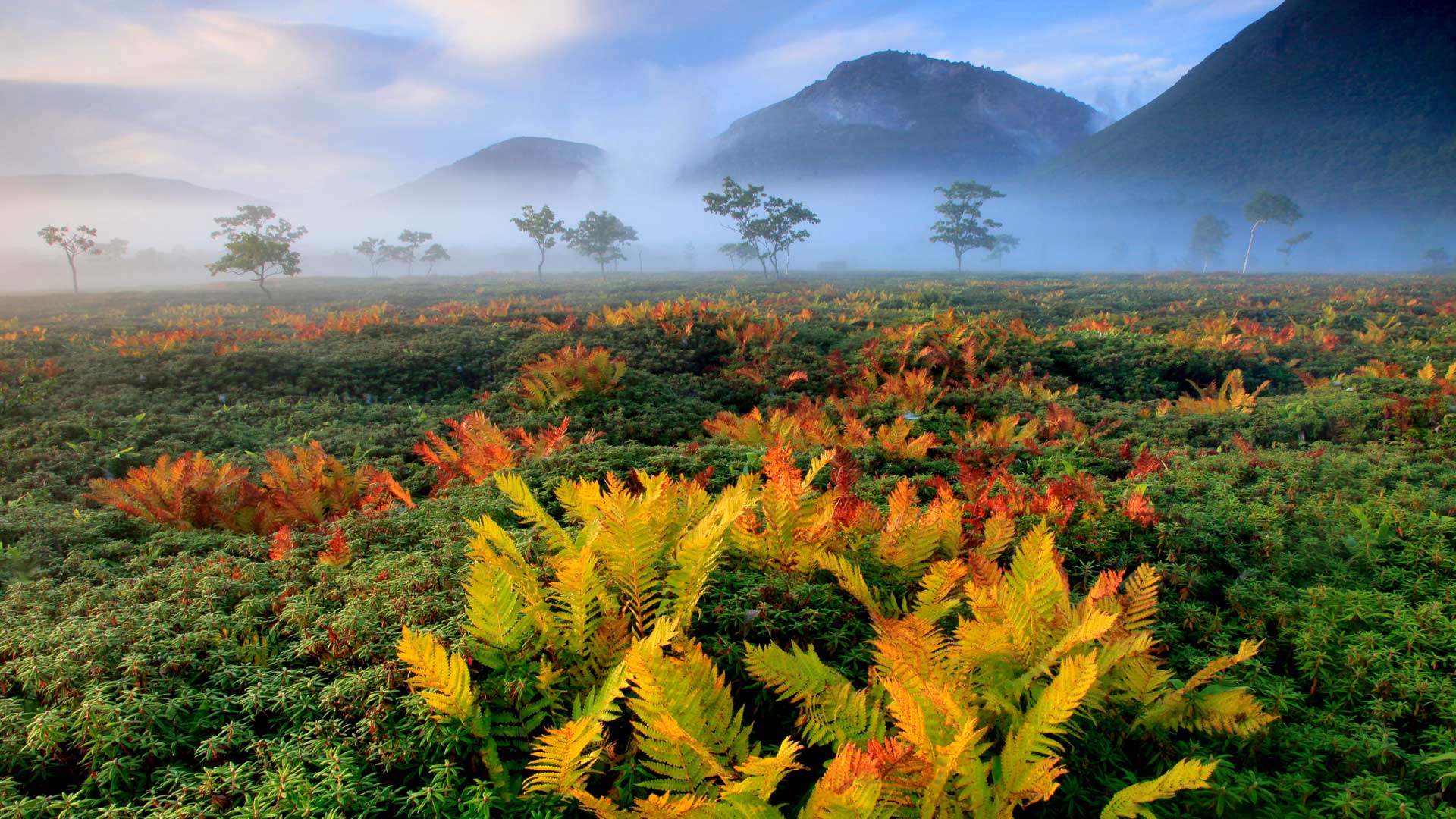伊豆半岛海岸附近的 Minokake-Iwa 奇岩群,日本 The Minokake-Iwa rocks off the coast of the Izu Peninsula, Japan (© Krzysztof Baranowski/Getty Images)
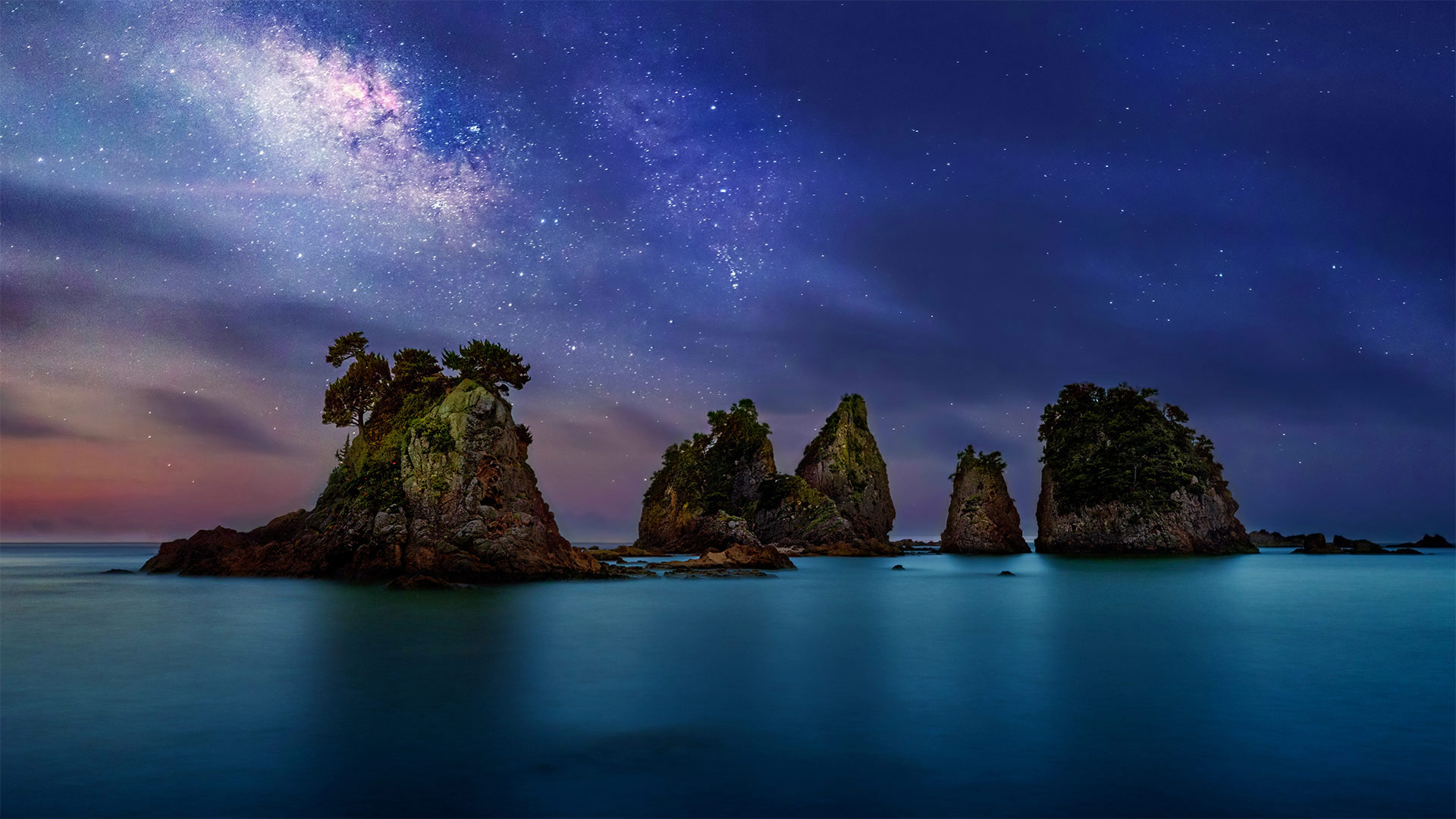
伊豆半岛海岸附近的 Minokake-Iwa 奇岩群,日本 The Minokake-Iwa rocks off the coast of the Izu Peninsula, Japan (© Krzysztof Baranowski/Getty Images)
Singing praises of the oceans
In Japan, mid-July brings an excuse to head to the beach, as if we really needed one. That's because this time of year marks Marine Day (aka Ocean Day), an observance recognizing the close bond the island nation shares with the seas and ocean that surround it. Because Marine Day roughly coincides with the end of the rainy season, it has, over the years, become a sort of unofficial kick off to the hot summer season. One place sure to attract visitors is the picturesque Minokake-Iwa rock formation seen here, lying off the coast of Honshū's mountainous 31-mile-long Izu Peninsula.
Ordinarily Marine Day is observed on the third Monday in July, but this year the holiday was moved to immediately precede the start of the Summer Olympics in Tokyo. So, this is the day to hit the beach in Japan, just before the Olympics' opening ceremonies begin tomorrow.
歌颂海洋
在日本,七月中旬给我们带来了一个去海滩的借口,好像我们真的需要一个。这是因为每年的这个时候都是海洋日(又名海洋日),这是一个认可岛国与周围海洋紧密联系的节日。由于海洋日大致与雨季的结束相吻合,多年来,它已成为炎热夏季的一种非正式开端。一个肯定会吸引游客的地方是这里风景如画的Minokake Iwa岩层,位于本什岛31英里长的伊豆半岛的海岸线附近。
通常海洋日是在七月的第三个星期一,但是今年这个节日被转移到了东京夏季奥运会开始之前。所以,今天是去日本海滩的日子,就在明天奥运会开幕式开始之前。
上高地 日本长野县, Kamikōchi, Nagano Prefecture, Japan (© sadao/Shutterstock)
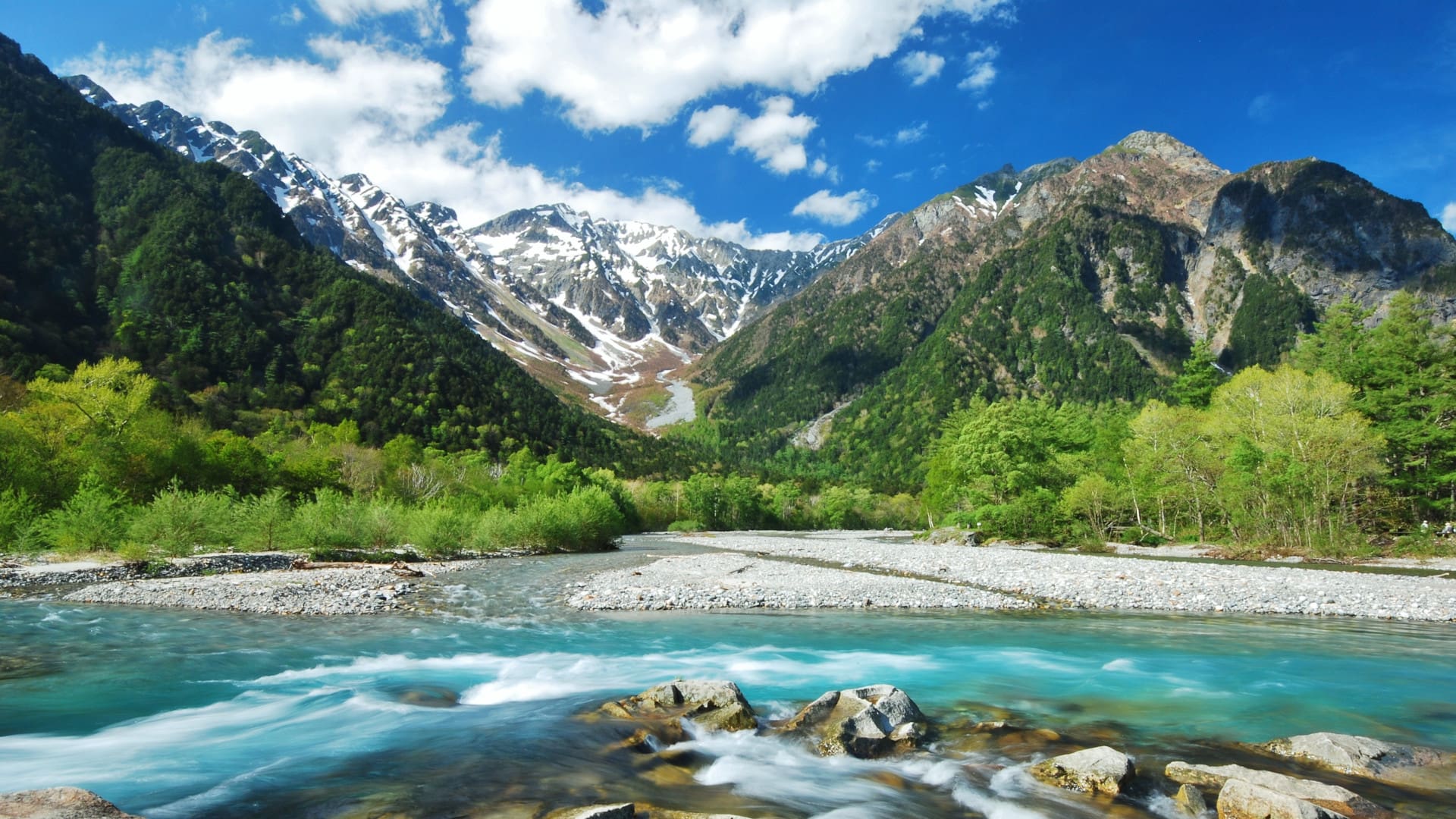
上高地 日本长野县, Kamikōchi, Nagano Prefecture, Japan (© sadao/Shutterstock)
"Kamikochi" Nagano Prefecture
Kamikochi, located in the valley of the Northern Alps, is a large plateau with abundant greenery. The original kanji is "Kamigakiuchi", and it was named because the deity of Hotaka Shrine, Hotaka Mikoto, descended to Mt. It was. It is also a hot spring resort, and there is also a hot spring inn where you can take a day trip bath ...
At an altitude of 1500 meters, the area has a wet continental climate, with cool summers and cold winters. It is blessed with a variety of vegetation because it extends from the mountainous area to the subalpine zone. The snowy landscape and the fresh green of early summer are wonderful, but the autumn leaves are also wonderful. Forests and lakes are inhabited by ancient Japanese creatures such as Japanese macaques, mallards, and chars.
长野县镰刀町
Kamikochi位于阿尔卑斯山北部的山谷中,是一个拥有丰富绿叶的大高原。原来的汉字是“Kamigakiuchi”,它的名字是因为和田神社的神,和田三谷浩田,下降到山。这也是一个温泉度假村,还有一个温泉旅馆,你可以在那里洗一天澡。。。
该地区海拔1500米,属湿润大陆性气候,夏季凉爽,冬季寒冷。它拥有丰富的植被,因为它从山区延伸到亚高山地带。白雪皑皑的景色和初夏清新的绿意是美妙的,但秋叶也是美妙的。森林和湖泊居住着古老的日本生物,如日本猕猴、野鸭和沙鼠。
日南市的萤火虫,日本鸟取县 Fireflies in Nichinan, Tottori, Japan (© north-tail/Getty Images Plus)
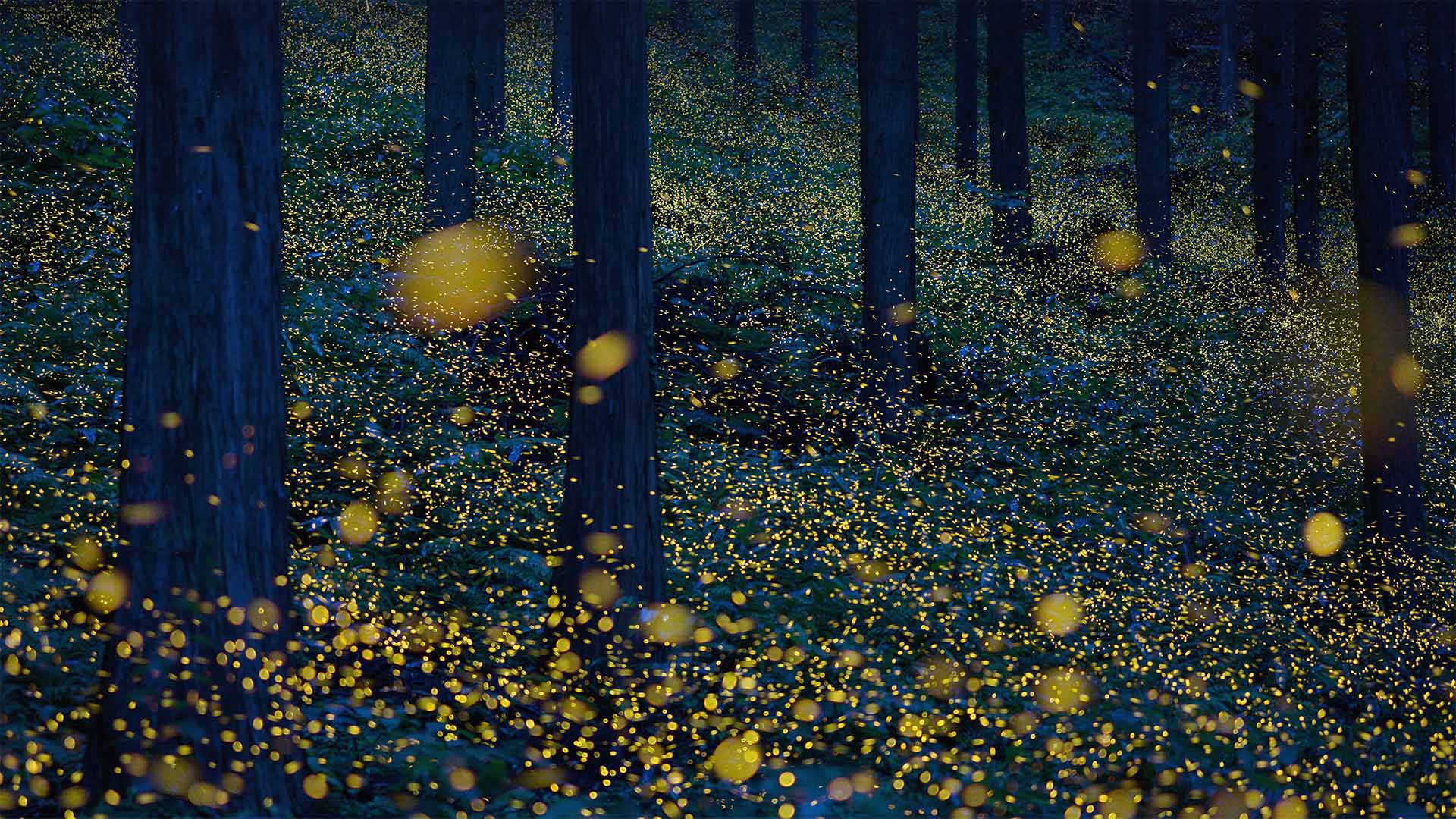
日南市的萤火虫,日本鸟取县 Fireflies in Nichinan, Tottori, Japan (© north-tail/Getty Images Plus)
A firefly frolic
You might be crashing the biggest party in Japan's least populous region. Each summer, fireflies turn this forest in rural Tottori prefecture into their own glitzy nightclub. There's no telling which fireflies are the males in this shot, but be assured they'll spend mating season trying to flicker their way into the females' hearts.
The buzzkill here is that fireflies' heyday each June and July amounts to their entire two-month adult lives—so when the rave dies, the flies shortly follow. Fortunately, that's plenty of time for the reveling bugs to produce countless eggs, soon to hatch into larvae who'll emerge from their pupae next summer and kick off the light show once again.
萤火虫嬉戏
你可能会毁了日本人口最少地区最大的派对。每年夏天,萤火虫都会把托托里县乡村的这片森林变成自己耀眼的夜总会。目前还不清楚哪只萤火虫是这张照片中的雄性萤火虫,但可以肯定的是,它们会在交配的季节里试图进入雌性萤火虫的心脏。
这里最有趣的是,萤火虫每年6月和7月的全盛期相当于它们整整两个月的成虫生活,所以当它们死去时,它们很快就会跟着死去。幸运的是,这是足够的时间,狂欢的虫子产生无数的卵,很快孵化成幼虫谁将出现在他们的蛹明年夏天,并启动灯光表演再次。
美瑛町的四季彩之丘,日本 Shikisai no Oka flower gardens in Biei, Japan (© Tanya Jones/Shutterstock)
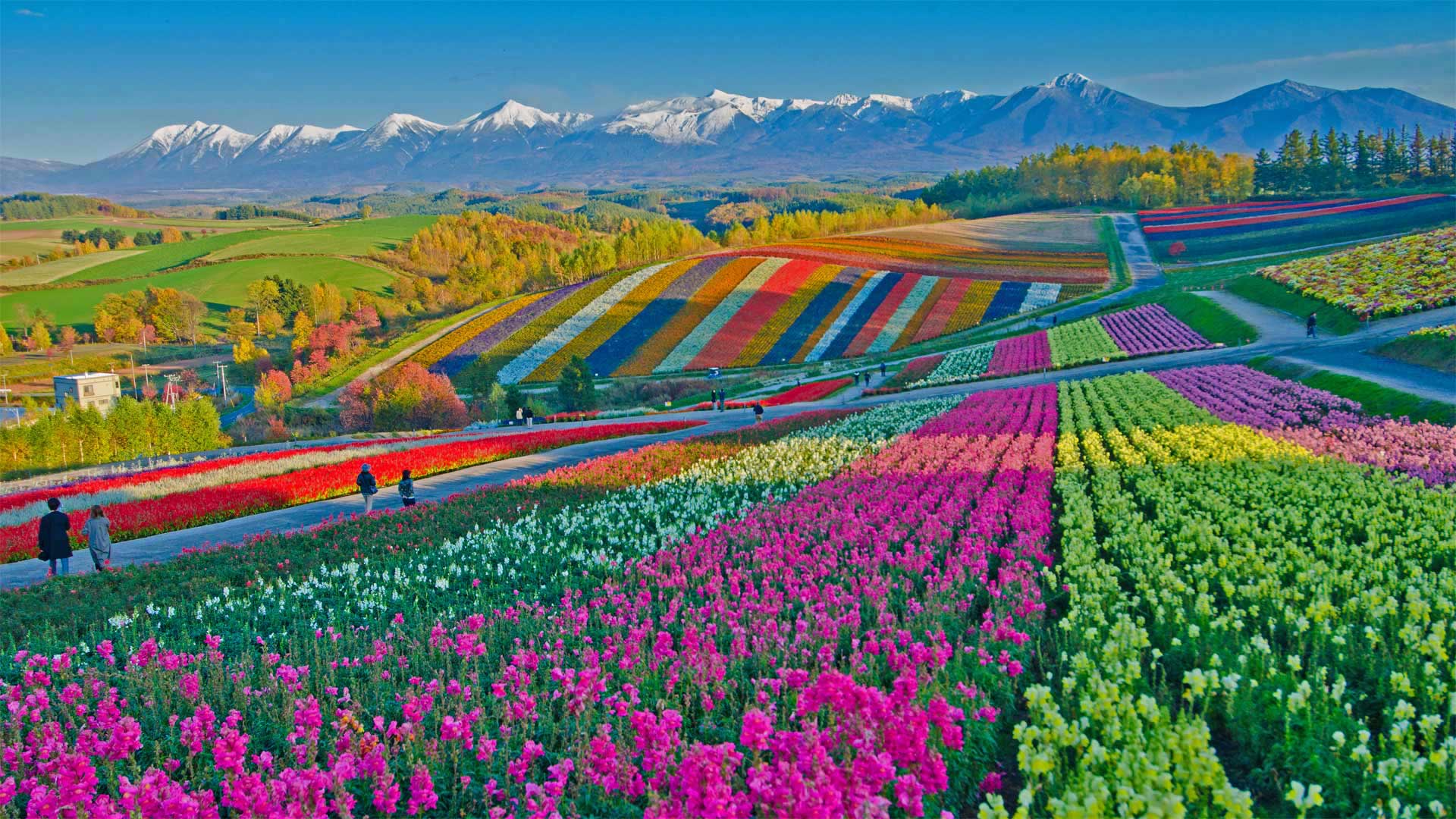
美瑛町的四季彩之丘,日本 Shikisai no Oka flower gardens in Biei, Japan (© Tanya Jones/Shutterstock)
Hues of Hokkaido
The Japanese prefecture of Hokkaido is known the world over as a winter wonderland. But once the snow melts, it's not long before the northerly island becomes a summery extravaganza of color. Just outside the town of Biei in central Hokkaido's hilly highlands, gardeners cultivate a rainbow blanket of tulips, lupine, marigolds, dahlias, and many more flowering plants. So wide is the assortment here at Shikisai no Oka (meaning 'Hills of Seasonal Colors') that if you visit between April and October, you're sure to find at least one type of flower in full bloom.
北海道的色调
日本北海道县被全世界称为冬季仙境。但一旦雪融化,不久,北风岛就变成了夏季色彩的盛宴。就在北海道中部丘陵高地的碧井镇外,园丁们种植着一片彩虹般的郁金香、羽扇豆、万寿菊、大丽花和更多的开花植物。Shikisai Nooka(意为“季节性色彩的山丘”)的品种繁多,如果你在4月至10月期间造访,你肯定会发现至少有一种花开得很茂盛。
吉野山,日本奈良 Mount Yoshino, Nara Prefecture, Japan (© Sean Pavone/iStock/Getty Images Plus)
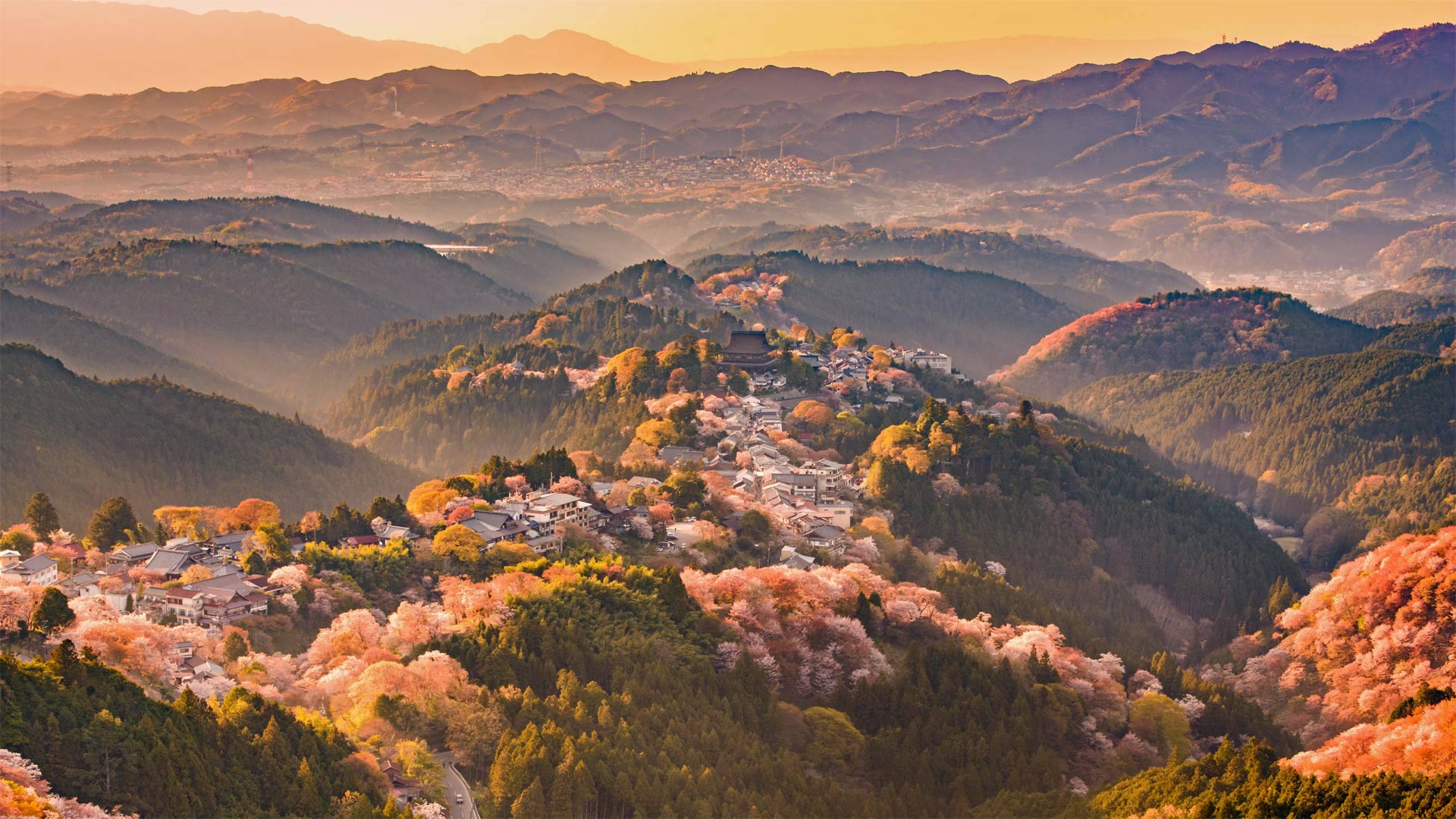
吉野山,日本奈良 Mount Yoshino, Nara Prefecture, Japan (© Sean Pavone/iStock/Getty Images Plus)
The mountain of 30,000 sakura
Mount Yoshino ranks as one of the best places in Japan to immerse yourself in the spring cherry blossom season. Over 30,000 flowering Japanese cherry trees, or sakura, grow in four main groves on the hillside. Because the trees, some planted over 1,300 years ago, grow at different elevations, the cherry blossom front gradually moves up the mountain in a slow, fragrant wave as the season progresses. Peak bloom usually arrives between early and mid-April. Most years, crowds wander through the town of Yoshino, visiting its traditional temples and shires, before admiring the profusion of cherry blossoms, a custom known as hanami. Of course, we can practice hanami virtually with pictures. But if you're lucky enough to have a blooming cherry tree near you, we encourage you to pause and breathe the moment in.
樱花山
吉野山是日本最适合在春天樱花盛开的地方之一。在山坡上的四个主要小树林里,生长着3万多株开花的日本樱花树。因为这些树,有些是1300多年前种植的,生长在不同的海拔高度,樱花阵面随着季节的推移,以缓慢而芬芳的波浪向山上逐渐移动。开花高峰期通常在4月初至中旬之间。大多数年,人们在吉野镇漫步,参观传统的寺庙和山寨,然后欣赏樱花盛开的景象,这是一种被称为花美的习俗。当然,我们可以用图片来练习花美。但如果你有幸在你身边有一棵盛开的樱花树,我们鼓励你停下来呼吸一下。
夜晚的纳巴纳之佐藤花园, 夸纳, 日本 Nabana no Sato garden at night in Kuwana, Japan (© Zoonar GmbH/Alamy)
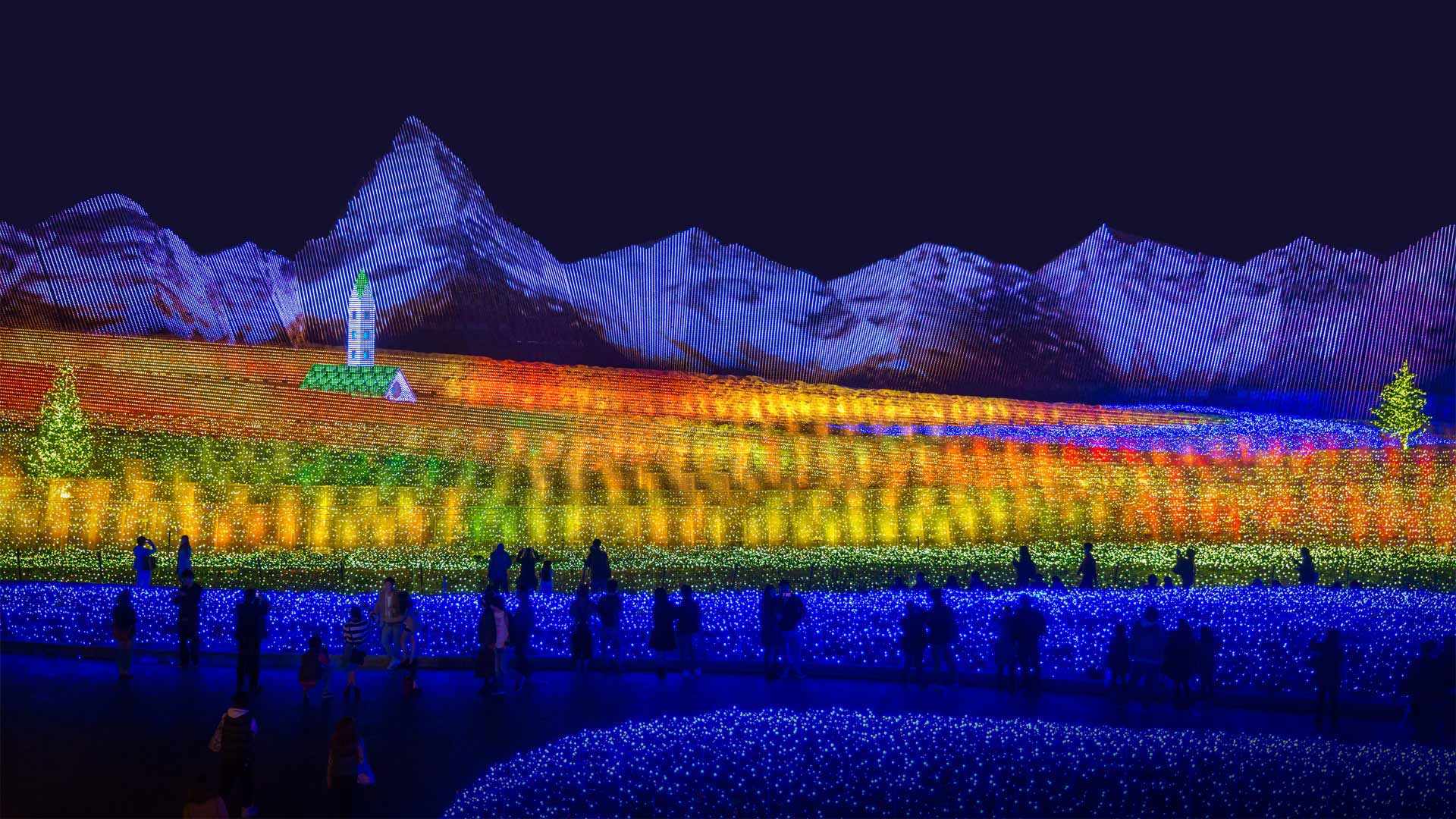
夜晚的纳巴纳之佐藤花园, 夸纳, 日本 Nabana no Sato garden at night in Kuwana, Japan (© Zoonar GmbH/Alamy)
Turning darkness into light
Winter illuminations are a big deal in Japan and there is perhaps no bigger display than the one here at Nabana no Sato, a flower park in the gardens of Nagashima Spa Land in Kuwana, Japan. This image is just a glimpse of what awaits you in the park. More than 8.5 million LED lightbulbs illuminate pathways, trees, and the park's famous 'Tunnel of Lights.' While many of Japan's light displays end after the new year, this one lasts from mid-October through early May.
将黑暗变成光明
在日本,冬季的照明很重要,也许没有什么比在日本的桑名市长岛温泉乐园的花园里的一个花园“纳瓦纳之佐藤”的展览更大。 此图像只是公园里的一瞥。 超过850万个LED灯泡照亮了道路,树木和公园著名的“光之隧道”。 尽管日本的许多灯光展示都是在新年之后结束的,但这个灯展时间是从10月中旬到5月初。
冬天的金阁寺,日本京都 Kinkakuji temple in winter, Kyoto, Japan (© yoko_ken_chan/Shutterstock)
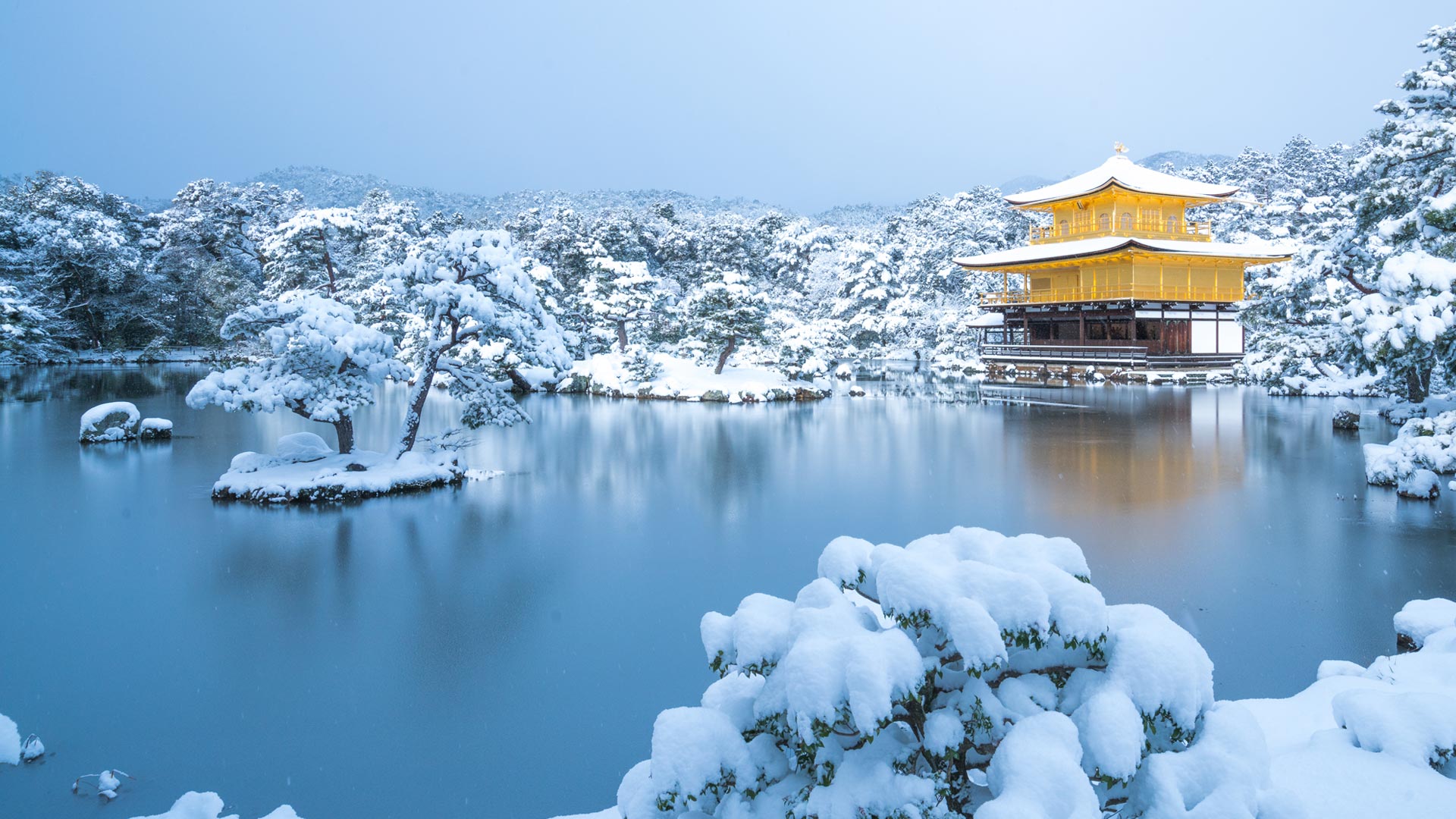
冬天的金阁寺,日本京都 Kinkakuji temple in winter, Kyoto, Japan (© yoko_ken_chan/Shutterstock)
Stunning in winter
Kinkakuji, also known as the Golden Pavilion, is one of the most famous sights in Kyoto. The golden temple that is actually made of gold, has been a popular attraction for many. During the winter, the white color of the snow contrasts beautifully with the color of the temple creating a breathtaking sight.
冬天惊艳
金阁寺,也被称为金阁,是京都最著名的景点之一。 实际上由黄金制成的金殿,已成为许多人的热门景点。 在冬季,雪的白色与寺庙的颜色形成了鲜明的对比,营造出令人叹为观止的景象。
日本北海道 (© Hiroshi Yokoyama/eStock Photo)
冈山沿岸的发光海洋萤火虫,日本 Bioluminescent sea fireflies along the shore of Okayama, Japan (© tdub_video/Getty Images)
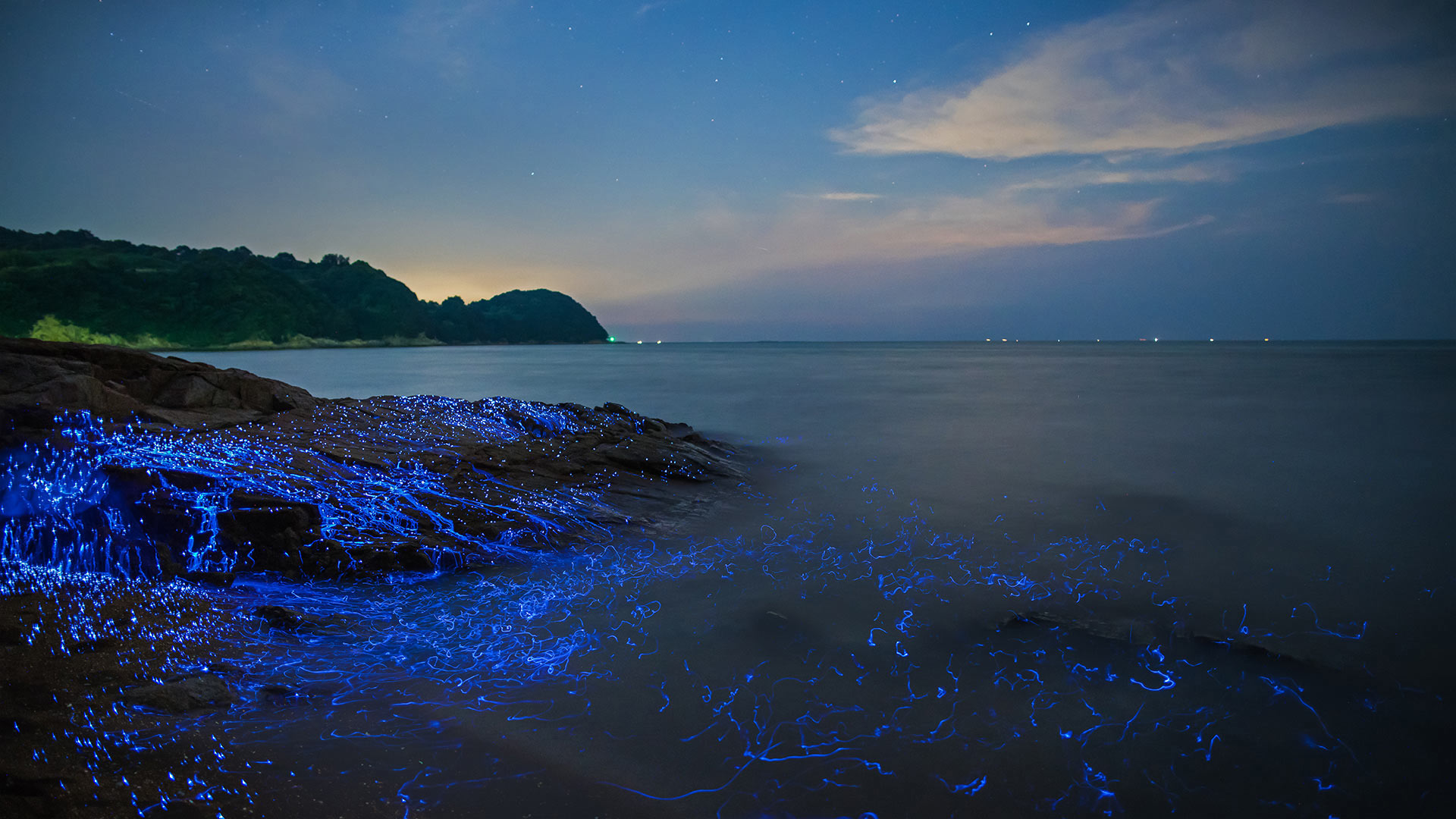
冈山沿岸的发光海洋萤火虫,日本 Bioluminescent sea fireflies along the shore of Okayama, Japan (© tdub_video/Getty Images)
Sea fireflies at the seashore
Sea fireflies may glow like the fireflies that send out backyard beacons at night, but that's about where the similarities end between the two species. Scientists call the bioluminescent crustaceans washing over these rocks Vargula hilgendorfii, and here in Japan they're commonly known as umi-hotaru. They're visible at night in the shallow sea waters and beaches of Japan, although other species of the genus Vargula can be seen glowing in the waters of the Gulf of Mexico, the Caribbean Sea, and off the California coast. Each sea firefly is about the size of a sesame seed, yet as a group they set off an impressive aura. Their glow intensifies depending on the salinity of the sea water and other physical stimuli. Besides lighting up the shores at night, the crustaceans do their part cleaning up the beach by munching on sandworms and dead fish. That's just one less thing for beachcombers to worry about during a glimmering seaside walk.
Notojima岛附近的牡蛎养殖场,日本石川县 Oyster farm offshore from Notojima Island, Ishikawa Prefecture, Japan (© divedog/Shutterstock)
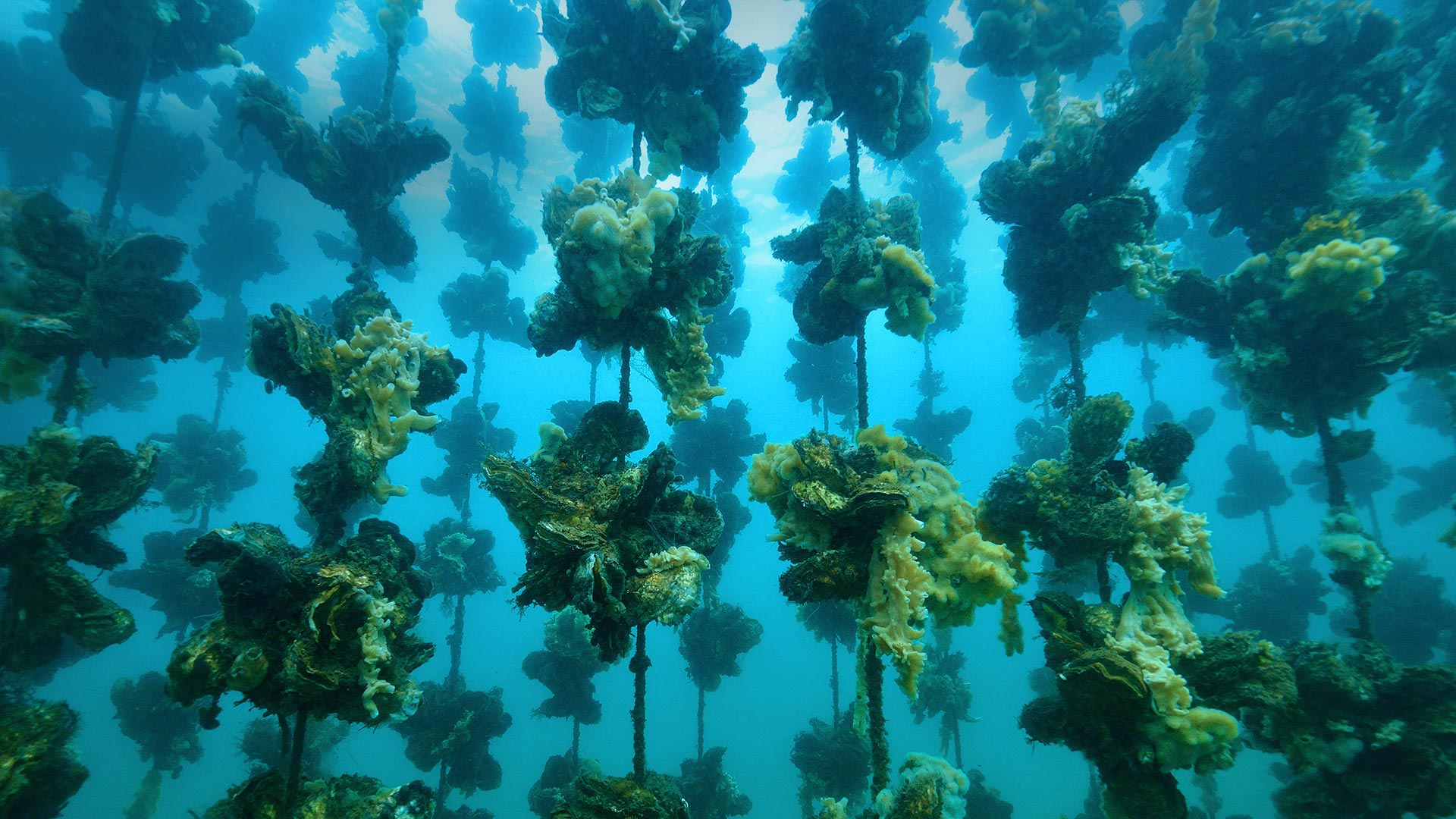
Notojima岛附近的牡蛎养殖场,日本石川县 Oyster farm offshore from Notojima Island, Ishikawa Prefecture, Japan (© divedog/Shutterstock)
Aw shucks, It's Oyster Day
It may look like we've led you into a squishy green minefield, but don't worry, these clustered oysters will only explode with flavor. In honor of Oyster Day, August 5 of each year, we're getting a glimpse of just one method of oyster mariculture, or farming in open seawater. The briny bivalves may be grown on beds, rods, racks, or—in this case—ropes, but the basic process is simple: Growing surfaces are 'seeded' with whole or ground oyster shells before oyster larvae are introduced. The shells attract the larvae, which attach themselves and soon grow into a new layer of mature oysters. Humans have been doing this at least since the days of ancient Rome, but wild-picked oysters have been an important food source to many cultures since prehistory.
Oysters also played an important role in US history, and could impact the future of our biggest city: Until the 1800s, New York Harbor was home to a trillion or more oysters, possibly half the world's supply. Naturally growing on craggy, reeflike beds on the harbor floor, they formed strong barriers against swelling storms. By the 20th century, overharvesting and pollution had decimated New York's oyster population. When Hurricane Sandy hit the NYC region in 2012, it highlighted the city's vulnerability to extreme weather, especially as ocean levels continue to rise. Since then, initiatives have aimed to seed new beds with oyster shells, many collected from local restaurants.
